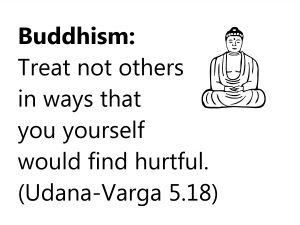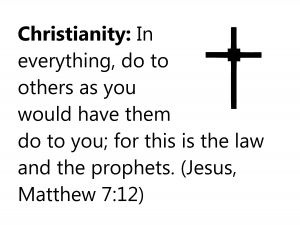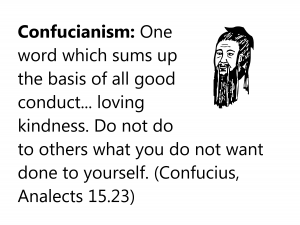Workshop outline in 13 steps:
Here follows a framework of 13 steps to guide the planning group in developing and presenting its workshop. As an aid to the planning group and facilitator, these steps are listed in both short form and long form:
 Step 1 – Welcome & Introduction
Step 1 – Welcome & Introduction
Step 2 – Distribution of Sacred Texts
Step 3 – Silent Meditation
Step 4 – Individual Reflection
Step 5 – Preparation for Group Discussion
Step 6 – Group Discussion
Step 7 – Plenary Discussion
Step 8 – Appropriation of Learnings
Step 9 – Sharing of Learnings
Step 10 – Facilitator’s Comments
Step 11 – Evaluation
Step 12 – Next Steps
Step 13 – Closing Prayer/Meditation
Step 1 – Welcome & Introduction
Facilitator welcomes the participants and outlines the program and process of the workshop. If the group is not too large, participants can be asked to introduce themselves and comment on what attracted them to this workshop.
Step 2 – Distribution of Sacred Texts
Facilitator provides each participant with a sheet containing the
13 written versions of the Golden Rule.
Step 3 – Silent Meditation
All participants are invited to spend a few minutes in silence, reading and reflecting on the 13 Sacred Writings. Facilitator can explain that the practice of reflection and meditation on sacred texts in silence is common to many religious traditions.
Suggested time frame: 5 to 7 minutes
Step 4 – Individual Reflection
Workshop participants continue their private and silent reflection in response to two or three questions provided them by the facilitator. The questions can also be listed on a flipchart. Participants may wish to journal their reflections. Suggested time frame: 7 to 12 minutes.
Prior to the workshop, the planning group prepares two or three questions appropriate to its audience, to stimulate private reflection and group discussion. The planners may want to provide just one question. On the other hand, they may choose more than two or three questions, perhaps as many as five or six. By increasing the number of questions, the planners are able to provide more rich material for reflection. However, more questions may lead to overstimulation of the individual reflections and of the subsequent small group process and plenary. So again, this is a decision for the planning group.
If the constituency is a specialized group (e.g. hospital chaplains, teachers, teenagers, social justice activists), questions can be geared to its specific needs. If the constituency wants to deal with a specific issue (e.g. ecology, social justice, violence, compassion), the questions can likewise be oriented to such.
Numerous sample questions are listed below, by clicking each of the three categories:
a) the message of the Golden Rule,
b) the message of the Golden Rule for you,
c) the Golden Rule and its implications for society
Step 5 – Preparation for Group Discussion
Each participant prepares for the small group discussion by quietly reflecting for a few minutes on the fruit of her/his meditation in Step 4. To stimulate this reflection, the facilitator provides each participant with the following questions (please note that the purpose here is not to repeat or rehash the reflection of the previous step but to prepare the participant for the small group discussion.):
- What new insights, thoughts, questions or good ideas do I have
as a result of my reflection on these Sacred Writings? - What feelings surfaced in me as I perused these writings?
- What would I like to share with my small group?
- How will I share, briefly, but completely?
Journaling is optional. Suggested time frame: 3 to 5 minutes
Step 6 – Group Discussion
Participants break into discussion groups (4 to 7 persons per group). The planning group may want to designate group leaders in advance. Suggested time frame: 20 to 45 minutes
Step 7 – Plenary Discussion
Facilitator convenes all participants into a plenary. Participants are invited to give feedback by way of either group reports or spontaneous comments. It may be helpful to record key elements of the feedback content on flip chart paper. Following the feedback, the facilitator stimulates discussion within the plenary. Suggested time frame: 20 to 45 minutes
Step 8 – Appropriation of Learnings
Facilitator asks each participant to take some quiet time (4 to 7 minutes) to reflect on her/his experience of and learnings from the program (journalling is optional). Some of the following questions can be used to stimulate private reflection:
- What have I learned during this workshop?
- What new insights have surfaced for me?
- What is coming clearer to me, now?
- As a result of this workshop, I feel moved to……
Step 9 – Sharing of Learnings
Facilitator asks some or all of the participants to share one learning from the program. These could be recorded on a flip chart. Alternatively, these learnings could also be shared in groups of two.
Step 10 – Facilitator’s Comments
At this point, the facilitator may want to share some specific or general comments on the notion of The Golden Rule Across The World’s Religions. The facilitator may also want to comment on the feedback reports and plenary discussion and make a summary statement.
Step 11 – Evaluation
Participants are invited to evaluate the workshop process. The planning group may design evaluation forms in advance.
Step 12 – Next Steps
The facilitator and participants take some time to determine if they want to do any follow-up to this workshop. For example, would it be helpful to organize additional workshops? Or to integrate the themes and learnings of this workshop into other projects that the participants or planning group are involved in?
Step 13 – Closing Prayer/Meditation
Workshop could close with an experience of prayer/meditation/liturgy/song/poetry/chant related to the theme. One option is to have people meditate quietly for a minute on the Sacred Writings. Following this, 13 individuals can recite, one-by-one, in a rotation fashion, the individual sacred texts.


